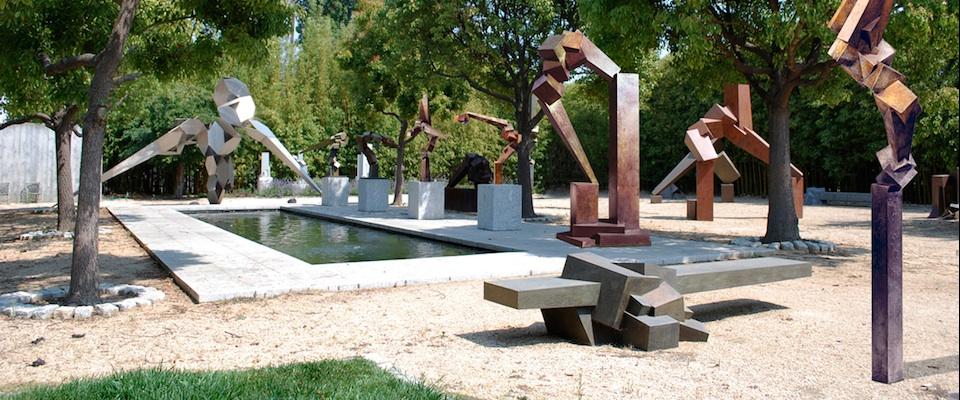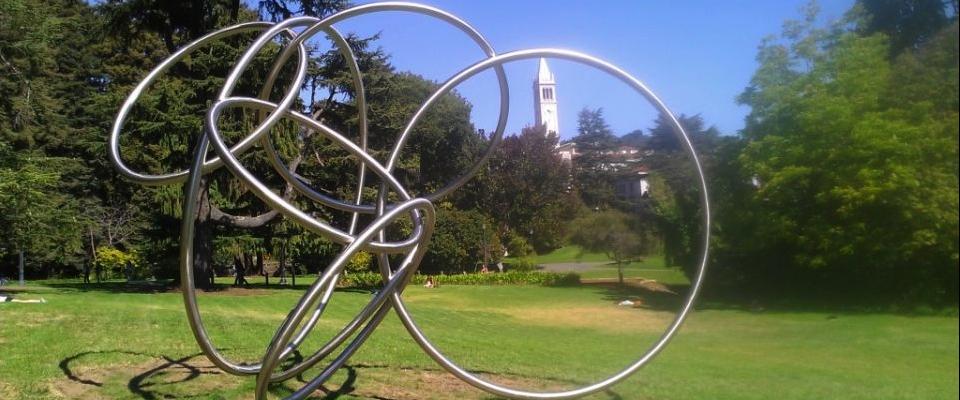New York City or West Oakland? That was the choice facing young sculptor Bruce Beasley after his graduation from UC Berkeley in 1962. New York City was, as now, the epicenter of the art world, bursting with energy and promise, and teeming with young, aspiring artists from around the world. West Oakland, on the other hand, was an all but forgotten wasteland—impoverished, neglected, and crime-ridden. Yet, somehow, Beasley glimpsed opportunity.
“Rough as it appeared to the eye,” he said in a recent speech, “it seemed like a good place to be.”
That “good place” suffered from intermittent electricity outages, crumbling sidewalks, and packs of stray dogs that roamed the streets, among many other issues. Undeterred, Beasley bought an abandoned West Oakland warehouse, converted it to a foundry, and never looked back.
This October 9, Beasley formally bequeathed that foundry, along with the rest of his ever-expanding studio compound, to the Oakland Museum of California (OMCA). Renowned for his innovative work in a variety of materials, Beasley’s often-massive, geometric sculptures have been featured in countless museums and exhibitions around the world. His impact on the sculpture world is undisputable, but for the West Oakland neighborhood, where he chose to spend his entire career and raise his family, his greatest impact has been on the community itself.
By the time Beasley purchased his West Oakland warehouse, he had already sold art to several prominent museums including the Museum of Modern Art and the Guggenheim in New York City. After renovating the warehouse, Beasley steadily acquired adjacent derelict lots (including a junkyard), converting them into studios, galleries, and even a sculpture garden. The result was an unlikely art oasis in the midst of a “no go” neighborhood.

From within this compound, Beasley churned out a prolific body of work over the subsequent years, rising in prominence and garnering international acclaim. He is known for his complex, abstract sculptures based on geometric forms.
“Sculpture is the emotional language of shape,” Beasley says. “Geometry is the intellectual language, but sculpture is the poetry.”
His work has made ripples beyond the art world due to his interest in technology and his innovative techniques with tricky materials. In the late 1960s, in an effort to create a 13-ton transparent sphere out of acrylic, he developed a casting process that continues to be used to fabricate all-transparent bathyspheres for deep-sea exploration.
While Beasley’s work was impacting the world at large, in West Oakland he quickly established himself as a community leader, dedicated to transforming the neighborhood surrounding his studio.
“I became immersed in community activities,” Beasley said in a press release, and soon after his arrival “founded the South Prescott Neighborhood Association, which is now the oldest community organization in West Oakland.” The group fought for community improvements such as sidewalks and streetlights.
During that time, Beasley met social activist Paul Cobb, now publisher of the Post News Group. At the October 9 ceremony, Cobb, a West Oakland native, praised Beasley’s commitment to their community. Together, Cobb said, they battled PG&E, the railroads, the city, county, and the state in efforts to force those institutions to pay proper attention to the neglected area. Cobb said that Beasley had a knack for “artfully spanking” those in positions of power.

Beasley’s wife, Laurence, recalled such an episode. Southern-Pacific Railroad owned the land in the neighborhood, charging exorbitant rents on buildings it barely maintained. Believing his neighbors would be better off owning the houses themselves, Beasley and the neighborhood organization rallied the community in an effort to buy them from the railroad. He negotiated with Southern Pacific, and eventually the company agreed to the deal on the condition that all the houses, without exception, be purchased in a single, cash transaction. When the day came to pay, one neighbor was $250 short. The railroad balked, but Beasley fought back, threatening to go to the press. Southern-Pacific ultimately accepted the deal—though it put the man on a payment plan to make up the missing $250.
“Beasley was instrumental in making West Oakland no longer neglected, abandoned, and in the dark,” Cobb said in a statement released by OMCA. “He reshaped our place with his community involvement and, with us, fought the powers that be to make sure that our community became a better place to live.”
When Beasley dies, the entire studio complex, including Beasley’s collection of his own work and related archival materials, along with a supporting endowment, will be donated to OMCA at an estimated value of $20 million. It will be the largest single private gift in the museum’s history, and for Beasley, a capstone on decades of community involvement.
OMCA envisions the future Bruce Beasley Sculpture Center as an active community hub for West Oakland. It will serve as a satellite museum, exhibiting Beasley’s work and that of other sculptors. There will also be artist residencies, public programming, and opportunities for scholarship, writing, and research.
Such opportunities, says Beasley, are especially important for young sculptors. “[Sculpture] is the most difficult and demanding of all the visual arts to both create and exhibit.” Because sculpture requires the most studio space to display, Beasley says, it can be difficult for practitioners to find venues for their art. The future Sculpture Center would provide just such a space.

In the years since Beasley established his compound, other arts organizations such as The Crucible and American Steel Studios have emerged in West Oakland. The result is that the neighborhood is now becoming a nationally recognized hub for sculpture.
Beginning next year, the Sculpture Center will be open to the public at least once a year, providing a preview of what’s to come after Beasley’s death. In the meantime Beasley, now in his mid-70s, remains active with his artwork and with local causes.
The Beasley Sculpture Center will also provide a bright spot in a neighborhood that can sorely use one. Bridgette Cook ’96, aide to District 3 Councilmember Lynette Gibson McElhaney ’97, says, “Other areas can point with pride to beautiful spaces,” and when the Sculpture Center opens, West Oakland will do that too.




















